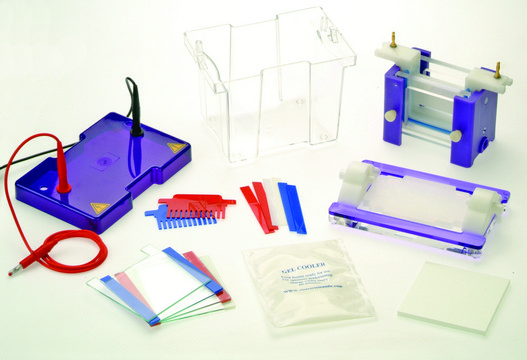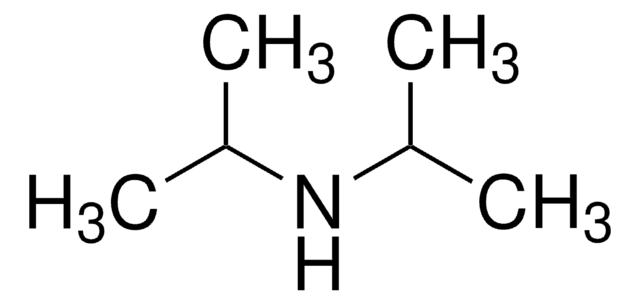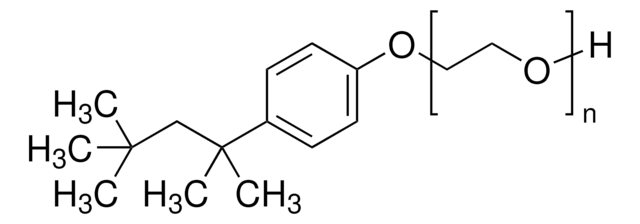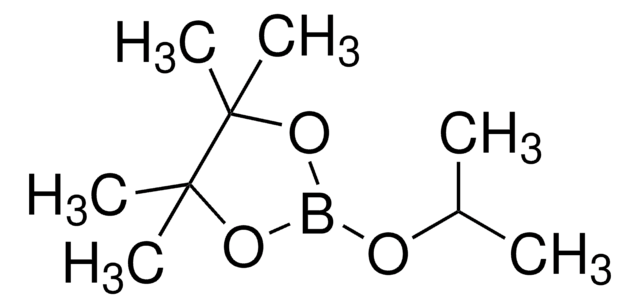186171
n-Butyllithium solution
1.6 M in hexanes
Synonym(s):
n-BuLi, Butyl lithium, Butyllithium solution, Lithium-1-butanide
About This Item
Recommended Products
form
liquid
Quality Level
concentration
1.6 M in hexanes
density
0.68 g/mL at 25 °C
storage temp.
2-8°C
SMILES string
[Li]CCCC
InChI
1S/C4H9.Li/c1-3-4-2;/h1,3-4H2,2H3;
InChI key
MZRVEZGGRBJDDB-UHFFFAOYSA-N
Looking for similar products? Visit Product Comparison Guide
Application
- Copolymerization of butadiene and styrene under the influence of n-butyllithium: This study explores the copolymerization process using n-butyllithium as a catalyst, which is significant for the development of new synthetic rubber materials (V Bronskaya et al., 2023).
- Modifiers of n-Butyllithium in the Synthesis of Polybutadiene and Styrene-Butadiene Rubbers: Explores the use of n-butyllithium with different modifiers in the synthesis of industrial rubbers, important for understanding the control of polymer properties (VS Glukhovskoi et al., 2014).
- Aggregation and Solvation of n-Butyllithium: Examines the aggregation behavior and solvation properties of n-butyllithium in various solvents, providing insights into its chemical interactions essential for organic synthesis (O Tai et al., 2017).
Packaging
The 25 mL Sure/Seal™ bottle is recommended as a single-use bottle. Repeated punctures will likely result in decreased performance of product.
Other Notes
Legal Information
related product
Signal Word
Danger
Hazard Statements
Hazard Classifications
Aquatic Chronic 2 - Asp. Tox. 1 - Eye Dam. 1 - Flam. Liq. 2 - Pyr. Liq. 1 - Repr. 2 - Skin Corr. 1B - STOT SE 3 - Water-react 1
Target Organs
Central nervous system
Supplementary Hazards
Storage Class Code
4.2 - Pyrophoric and self-heating hazardous materials
WGK
WGK 3
Flash Point(F)
-14.8 °F - closed cup
Flash Point(C)
-26 °C - closed cup
Regulatory Information
Choose from one of the most recent versions:
Already Own This Product?
Find documentation for the products that you have recently purchased in the Document Library.
Which document(s) contains shelf-life or expiration date information for a given product?
If available for a given product, the recommended re-test date or the expiration date can be found on the Certificate of Analysis.
How do I get lot-specific information or a Certificate of Analysis?
The lot specific COA document can be found by entering the lot number above under the "Documents" section.
How are the 100 mL, 800 mL, and 1 L unit sizes of Product 186171, Butyllithium solution, packaged?
They are packaged in our Sure-Seal™ bottle, which have a crown cap with a PTFE/elastomer liner crimped into place.
How are the 8 L and 18 L unit sizes of Product 186171, Butyllithium solution, packaged?
They are packaged in our Kilo-Lab™ cylinder.
What should I do if precipitate is present in Product 186171, Butyllithium solution?
Haziness may form upon storage but does not affect the specification. If precipitation is present, then gently mix precipitate back into solution under an inert atmosphere.
What are common uses for Product 186171, Butyllithium solution?
Butyllithium is widely use as a polymerization initiator in the production of elastomers such as polybutadiene or styrene-butadiene-styrene (SBS). It is also broadly employed as a strong base (superbase) in organic synthesis, both industrially and in the laboratory.
Is it necessary to handle Product 186171, Butyllithium solution, under inert atmosphere?
This product ignites on exposure to air and should be handled under inert atmosphere such as under nitrogen.
How do I find price and availability?
There are several ways to find pricing and availability for our products. Once you log onto our website, you will find the price and availability displayed on the product detail page. You can contact any of our Customer Sales and Service offices to receive a quote. USA customers: 1-800-325-3010 or view local office numbers.
What is the Department of Transportation shipping information for this product?
Transportation information can be found in Section 14 of the product's (M)SDS.To access the shipping information for this material, use the link on the product detail page for the product.
My question is not addressed here, how can I contact Technical Service for assistance?
Ask a Scientist here.
Articles
Transformative reagents enable selective conversions within molecules containing sensitive functionalities under mild reactions.
Our team of scientists has experience in all areas of research including Life Science, Material Science, Chemical Synthesis, Chromatography, Analytical and many others.
Contact Technical Service










